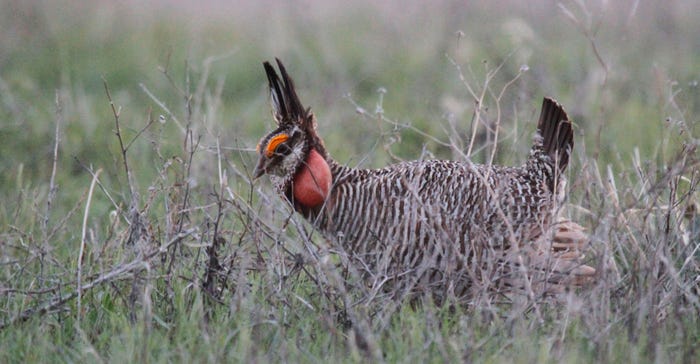October 14, 2019

By Michael Pearce
Environmental groups have again pressured the U.S. Fish and Wildlife Service to consider listing lesser prairie chickens under the federal endangered species act.
USFW officials will study population and habitat trends and make their decision known in May 2021.
Many Kansans remember the uncertainty, as per possible land-use limitations, that came when the birds were listed as “threatened” in 2014. A federal judge eventually overturned the listing. The Texas official cited improper procedure by the feds, and said that volunteer programs were helping the species recover from desperately low numbers due to loss of habitat and extreme drought.
Now the process, and possible problems, start again. Several agricultural and wildlife conservation groups are working to detour, or at least lessen the impact, of a future listing. Following is the current status and factors affecting the birds:
Population. Estimates put the range-wide lesser prairie chicken population at around 38,000 birds in their prairie habitats of Kansas, Oklahoma, Texas, New Mexico and Colorado. That’s similar to 2018. While an improvement over 18,000 in 2013, it’s well below the 60,000-plus goal set by USFWS.
About 70% of the birds are located in Kansas, largely because of strong population numbers in west-central Kansas. That’s roughly the area between Highway 96 and Interstate 70, from Highway 183 to the Colorado border.
Some estimates say Gove County has more lesser prairie chickens than Colorado, Texas and Oklahoma combined. Populations are recovering from serious drought and habitat changes in southwest Kansas and the Red Hills region, but remain far lower than 20 years ago.
Dave Haukos, of the Kansas Cooperative Fish and Wildlife Research Unit, says there ��“are hardly any” in Oklahoma and Texas. Many think the few birds living in Colorado are those transplanted from Kansas flocks.
Habitat trends. All grassland grouse require broad expanses of native prairies. Energy exploration and production, conversion of grasslands to croplands and extreme grazing practices, plus drought, helped push the birds into the current predicament. Encroachment of woody species, like eastern red cedar, have also been a problem.
Conversely, Conservation Reserve Program fields have greatly helped lesser prairie chickens, especially in times of extreme weather. Changes in the number of CRP acres across the lesser prairie chicken range will impact populations and listing decisions.
Weather patterns. Drought has long plagued lesser prairie chickens, which live in some of the most arid regions of the nation. It was thought droughts of the 1930s, 1950s and 1970s might make them extinct. In recent years, drought has reduced populations about 50% in one year. Wet years lead to population increases, but it often takes several consecutive years for numbers to build. Past recoveries were far easier because of more habitat.
As for climate change, Haukos says weather patterns have moved toward longer, more harsh droughts with extreme heat. “We had years [recently] in New Mexico when it was so hot the [females] didn’t even try to nest,” he says. “There’s no denying climate change has been causing issues, especially in the southern part of the bird’s range.”
Changing weather patterns and CRP could be leading the birds to shift their range northward, into the population-hotspots of west-central Kansas.
Voluntary programs
When the federal listing loomed about 10 years ago, many conservation and agricultural groups — including the Natural Resources Conservation Service, The Nature Conservancy, state wildlife agencies, state agriculture groups, and the Western Association of Fish and Wildlife Agencies — banded together and came up with voluntary land-use and habitat programs. Millions of dollars were raised. Thousands of acres of habitat were protected, improved or created.
The judge who overturned the past listing mentioned such programs. Many of the programs are still available. Those working to stave off another listing urge landowners to find one that’s right for them.
“There are no-one-size-fits-all solutions,” says Bill Van Pelt, with Western Association Fish and Wildlife Agencies. “We work with landowners to find what’s right for them and the birds. If something needs changed, like their cattle have to be taken off early, we compensate them for that. We want all ranchers to maintain a working ranch. If they have to, they can do it with a different revenue stream.”
People like Van Pelt and Haukos hope enrolling more lands in voluntary conservation efforts will keep the birds from being listed as threatened or endangered. If they do get listed, however, both said pre-enrollment in conservation programs will help many landowners get exemptions from some federal land-use requirements as per threatened or endangered species.
Van Pelt recommends landowners interested in enrolling in such conservation programs contact their local NRCS office.
Several western Kansas ranches are now working to educate the public on how good grassland management can benefit wildlife and cattle. Last spring people came from 32 states and 12 nations to Gove and Logan counties to watch lesser prairie chickens on their mating grounds.
Pearce writes from Lawrence.
You May Also Like




